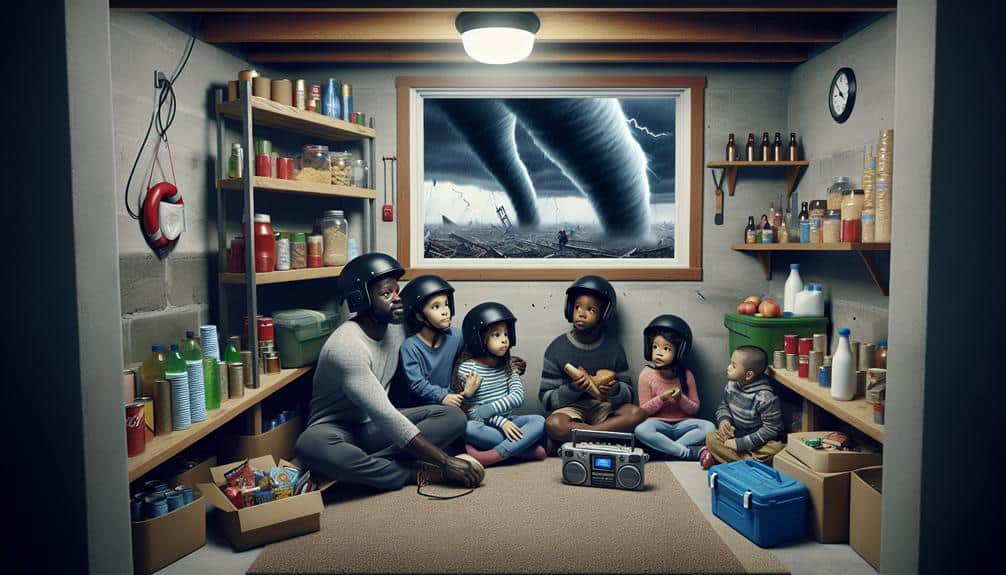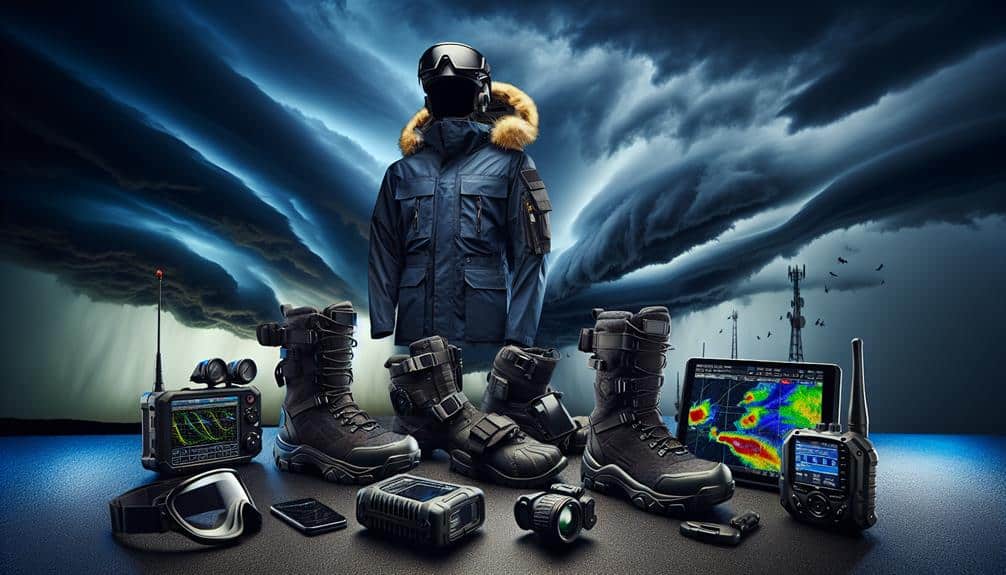During tornado intercepts, we must prioritize safety by integrating real-time weather updates, advanced forecasting models, and satellite imagery. Rely on well-maintained, precise equipment for data accuracy and operational safety. Identify and map out evacuation routes, dynamically adjusting them based on weather updates. Maintain at least a one-mile distance from a tornado's path using GPS and predefined safe zones. Guarantee team safety through continuous communication and emergency contact plans. Protective gear like helmets and safety goggles is essential. To conclude, comply with local guidelines and regional regulations. For a deeper understanding of these safety measures, keep exploring this subject.
Key Points
- Continuously monitor weather updates and warnings to stay informed about tornado developments.
- Maintain a minimum safe distance of one mile from the tornado's projected path.
- Use reliable equipment and ensure regular maintenance for data accuracy and safety.
- Establish and practice dynamic escape routes and identify nearby safe shelters.
Monitor Weather Updates
We must continuously monitor real-time weather updates through reliable meteorological sources to guarantee accurate tracking of tornado development and movement. By staying informed, we leverage advanced forecasting models and radar data to anticipate tornadic activity. High-resolution satellite imagery and Doppler radar provide significant insights into a storm's velocity, rotation, and potential path.
Utilizing data from the National Weather Service (NWS) and Storm Prediction Center (SPC), we can interpret mesoscale discussions and tornado watches/warnings with precision. These sources offer near-instantaneous updates, which are essential for timely decision-making. The integration of these updates into our tracking systems enhances situational awareness and allows us to adjust our intercept strategies accordingly.
It's important to remain vigilant and not underestimate the tornado's potential intensity. As we track the storm, our priority is to balance data analysis with safety protocols. If the data indicates an imminent threat, we must immediately seek shelter. This proactive approach minimizes risk and ensures our safety while maximizing our freedom to conduct intercept operations effectively.
Therefore, by diligently monitoring weather updates, we can maintain a strategic advantage and make informed decisions that prioritize both our mission objectives and our well-being.
Use Reliable Equipment
Reliable equipment forms the backbone of effective tornado intercepts, safeguarding data accuracy and operational safety. When we're out in the field, the integrity of our data hinges on the quality and reliability of our gear.
Proper equipment maintenance and use are essential to avoid failures that could compromise both our research and our safety. We must routinely inspect our instruments and vehicles, ensuring they're in top condition.
Technology upgrades play a pivotal role in maintaining data accuracy. As technology evolves, so should our gear. Implementing the latest advancements ensures more precise data collection, providing us with invaluable insights into tornado behavior. It's not just about having the best tools but knowing how to use them effectively.
Consider these crucial aspects:
- Preventative Maintenance: Regularly scheduled checks can avert unexpected breakdowns.
- Calibration: Accurate data relies on properly calibrated instruments.
- Software Updates: Keeping software up-to-date maximizes functionality and reliability.
Plan Escape Routes
To guarantee our safety during tornado intercepts, we must identify safe locations in advance, consistently monitor weather updates, and practice evacuation drills.
Accurate data on shelter availability and real-time meteorological information are critical for effective escape planning.
Regular drills enhance our response time and reduce the likelihood of errors under stress.
Identify Safe Locations
Identifying multiple secure locations and planning escape routes in advance maximizes our chances of survival during tornado intercepts. When we're out chasing storms, our freedom relies on thorough preparation.
First, we must evaluate our shelter options. Structures like reinforced storm shelters or basements provide prime protection. If those aren't available, we should look for sturdy buildings with interior rooms away from windows.
We also need to map out our evacuation routes thoroughly. Knowing which roads to take if a tornado heads our way can save us valuable seconds.
We should always consider:
- Proximity to safe shelters: Ensure we're never too far from a reliable shelter option.
- Multiple evacuation routes: Have at least two escape routes to avoid getting trapped by debris or traffic.
- Road conditions: Be aware of any potential road closures or construction that could hinder our escape.
Our mission is driven by data, and our safety measures should be no different. Analyzing shelter options and planning detailed evacuation routes empower us to intercept tornadoes while preserving our autonomy and well-being.
Monitor Weather Updates
Monitoring real-time weather updates is essential for adjusting our escape routes dynamically and ensuring our safety during tornado intercepts. Staying informed with the latest meteorological data allows us to make rapid decisions based on current storm trajectories and intensity levels.
Utilizing radar imagery, satellite feeds, and National Weather Service notifications, we can pinpoint areas of severe weather activity and plan our movements accordingly.
Our ability to stay informed hinges on reliable technology. We should employ high-resolution radar apps, NOAA weather radios, and GPS-enabled devices to receive minute-by-minute updates. These tools provide us with the vital information needed to navigate away from danger zones promptly.
Additionally, integrating storm chaser networks and social media updates can offer real-time insights from other professionals in the field.
Planning escape routes involves pre-determined, flexible paths that allow for quick evacuation. We must continually reassess these routes as new data emerges, ensuring we can seek shelter swiftly.
Practice Evacuation Drills
Practicing evacuation drills with thoroughness guarantees that our team can execute escape routes efficiently under high-stress conditions. By simulating tornado scenarios, we strengthen our response and make sure that every team member knows their role. This preparation minimizes confusion and maximizes our chances of safe evacuation.
Our drills aren't just routine; they're meticulously planned using detailed maps and real-time data. We focus on:
- Emergency protocols: Everyone must understand the procedures, from initial warnings to final evacuations.
- Route optimization: We analyze multiple egress paths to determine the quickest, safest options.
- Communication: Clear, concise communication channels are established, ensuring no one is left uninformed.
Data shows that well-practiced evacuation drills can reduce response times by up to 50%, a critical factor when seconds count. By involving the community, we foster a collaborative environment where everyone is prepared.
Our thorough approach to practicing evacuation drills not only safeguards our team but also empowers us with the freedom to act decisively and confidently during tornado intercepts.
Maintain Safe Distances
Maintaining a minimum distance of one mile from the tornado's projected path is essential to validate both observational accuracy and safety. This distance management strategy secures we remain within safe zones, reducing the risk of debris impact and allowing enough time for evasive maneuvers if the tornado changes direction unexpectedly.
According to meteorological data, a one-mile buffer provides a statistically significant reduction in injury risk, while still enabling effective datalogging and visual observation.
Precise distance management requires real-time updates and dynamic adjustments based on the tornado's speed and trajectory. We've found that using GPS-based tracking systems and radar data enhances our ability to maintain this critical distance. Additionally, having predefined safe zones established in advance can streamline our response during high-stress situations.
Effective team communication is paramount. We utilize emergency signals to rapidly convey changes in the tornado's path and our position relative to it. For instance, a series of short, predefined radio bursts can indicate an immediate need to reposition. This protocol certifies that all team members are synchronized and can act quickly to maintain safe distances.
Communicate With Team

We must prioritize real-time location sharing to guarantee every team member's position is continuously monitored.
Establishing emergency contact plans allows us to respond rapidly if communication lines fail.
Implementing signal check protocols at regular intervals will verify the integrity of our communication systems.
Real-Time Location Sharing
Sharing real-time location data secures that our team remains synchronized and can rapidly adjust to changing conditions during tornado intercepts. By utilizing advanced GPS and geospatial tracking technologies, we enhance our safety precautions and communication methods. Accurate location sharing secures that every team member knows the precise whereabouts of others, minimizing risks in a volatile environment.
Real-time location sharing provides several critical advantages:
- Immediate Awareness: We can instantly see each other's positions, enabling swift decisions.
- Enhanced Coordination: Accurate data allows us to move cohesively and avoid hazardous zones.
- Emergency Response: Quick identification of team members' locations secures prompt assistance if a situation escalates.
Emergency Contact Plans
Developing strong emergency contact plans ensures our team can communicate swiftly and effectively in pivotal situations. We need detailed contact protocols that specify primary and secondary points of contact for each team member. These protocols must be rehearsed through regular emergency drills to confirm everyone knows their role and responsibilities during a tornado intercept.
Our emergency procedures should also include family communication plans. Each team member must have a predetermined method to inform their families of their status and location, minimizing anxiety and confirming everyone is accounted for. We should use redundant systems, such as satellite phones and radio frequencies, to maintain contact even if primary communication networks fail.
Data from recent studies show that clear and practiced emergency procedures reduce response times by up to 40%. This efficiency is essential when seconds can mean the difference between safety and danger. By integrating these contact protocols into our routine, we enhance our operational fluidity and ensure no one is left in the dark.
Signal Check Protocols
Building on our emergency contact plans, implementing strict signal check protocols guarantees our team maintains continuous communication throughout the tornado intercept process. Adopting these protocols isn't just about enhancing our communication strategies; it's a pivotal safety precaution. Continuous signal checks allow us to monitor real-time data, ensuring we can react promptly to any sudden changes in weather patterns or team locations.
To fortify our signal check protocols, we've established the following procedures:
- Scheduled Check-Ins: Regular intervals for team members to report their status, making sure all members are accounted for.
- Redundancy Systems: Utilizing multiple communication channels (radio, cellular, satellite) to prevent loss of contact due to technical failures.
- Automated Alerts: Integrating systems that automatically alert the team if someone misses a check-in, prompting immediate follow-up.
These measures not only enhance our operational efficiency but also embed a layer of security that's indispensable during high-risk maneuvers.
Wear Protective Gear
Wearing protective gear, including helmets, safety goggles, and reinforced clothing, is important to mitigate the risk of injury during tornado intercepts. It's essential that our gear undergoes regular maintenance and checks to maintain its top condition.
Helmets should be inspected for any cracks or deterioration, as even minor damage can compromise their effectiveness. Safety goggles must be free of scratches to uphold visibility, and reinforced clothing should be examined for wear and tear that could reduce its protective capabilities.
Proper fit is another crucial aspect. Ill-fitting gear can lead to discomfort and reduced mobility, which may impede our ability to respond swiftly in high-risk situations. For helmets, adjustable straps should secure the fit without causing pressure points. Safety goggles need to form a seal around the eyes to prevent debris from entering, while maintaining comfort levels to avoid fogging and guarantee clear sightlines.
Visibility and comfort levels are key. Reinforced clothing, while protective, shouldn't restrict our movements or add unnecessary weight. By prioritizing gear maintenance and ensuring a proper fit, we can maximize both safety and freedom of movement during tornado intercepts. This approach allows us to operate effectively while minimizing risk.
Follow Local Guidelines

Adhering to local guidelines during tornado intercepts is crucial to safeguard our safety and compliance with regional regulations. When we're out in the field, understanding and following these guidelines guarantees that we're not just protecting ourselves but also respecting the community we're in.
Local authorities have specific recommendations on shelter options and emergency supplies tailored to the region's unique tornado risks. These guidelines are informed by years of data and are designed to save lives. We must familiarize ourselves with these protocols before heading out.
- Local shelter locations: Knowing the nearest storm shelters can be a lifesaver. These are often reinforced structures specifically designed to withstand tornadoes.
- Evacuation routes: Local guidelines typically include designated evacuation routes. These routes are chosen for their safety and accessibility during severe weather.
- Emergency supplies: Regional advice on what to carry can differ; however, basics like water, non-perishable food, first-aid kits, and communication devices are universally recommended.
Frequently Asked Questions
What Should I Include in My Emergency Supply Kit for Tornado Chasing?
When we're out chasing, our emergency supply kit needs essentials. Start with an emergency shelter, just in case. Include a detailed communication plan to stay connected. Don't forget food, water, first aid, and weather monitoring tools.
How Can I Identify Safe Structures to Take Shelter in During a Tornado?
We should prioritize shelter identification by selecting sturdy buildings with basements or interior rooms, ensuring they meet safety precautions. Our emergency preparedness involves analyzing structural integrity, avoiding mobile homes, and confirming quick access to these safe structures.
What Are the Best Practices for Driving in Severe Weather Conditions?
We should practice defensive driving, maintain road visibility, and adjust speed to weather conditions. Utilizing headlights, avoiding flooded areas, and staying informed through weather updates secures our safety and freedom to navigate severe weather confidently.
How Do I Handle a Vehicle Breakdown During a Tornado Intercept?
During a breakdown, we prioritize vehicle safety by immediately pulling off the road. We initiate emergency communication protocols, using radios and GPS to relay our position. It's essential we follow established procedures to guarantee everyone's safety.
What Steps Should I Take to Stay Calm and Focused During a Tornado Chase?
We should use mindfulness techniques and stress management to stay calm and focused. Mental preparation and coping strategies are essential. Analyzing weather data precisely while maintaining situational awareness guarantees we make informed, safe decisions during tornado chases.


